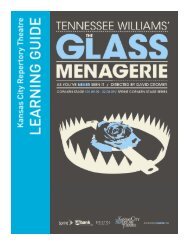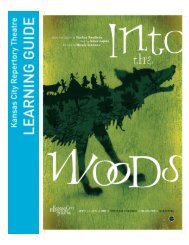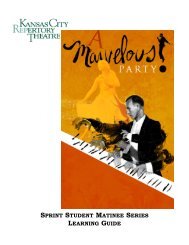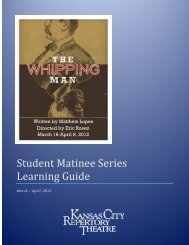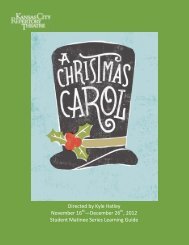Harriet Jacobs - The Kansas City Repertory Theatre
Harriet Jacobs - The Kansas City Repertory Theatre
Harriet Jacobs - The Kansas City Repertory Theatre
Create successful ePaper yourself
Turn your PDF publications into a flip-book with our unique Google optimized e-Paper software.
THE PLAY<br />
THE AUTHOR - CONTINUED<br />
Mother and daughter were secretly and briefly<br />
reunited in 1840, and Louisa Matilda was eventually<br />
taken to her cousin’s home in Brooklyn. Freedom for<br />
<strong>Jacobs</strong> came on June 10, 1842, when she and her son<br />
Joseph boarded a ship that would take them to<br />
Philadelphia, and eventually to New York.<br />
<strong>Jacobs</strong> made a new life in New York, at first working as<br />
a nursemaid and then attending the Young Ladies<br />
Domestic Seminary School. By 1849, she had joined<br />
her brother in Rochester, where they established the<br />
Anti-Slavery Reading Room and became actively<br />
involved in the anti-slavery movement, meeting<br />
Quaker Amy Post and her husband Isaac, both staunch<br />
abolitionists, Frederick Douglass and other prominent<br />
figures of the day.<br />
Although she was now living and working in the North<br />
and openly involved in the abolitionist movement,<br />
liberty for <strong>Jacobs</strong> was still elusive. When the 1850<br />
Fugitive Slave Law was passed, <strong>Jacobs</strong> was forced to<br />
flee Rochester to avoid recapture by Norcom’s<br />
daughter, Mary Matilda, who wanted her returned.<br />
Finally, in 1852, her employer and anti-slavery<br />
sympathizer, Mrs. Cornelia Willis, contracted the<br />
Colonization Society to buy the freedom of <strong>Jacobs</strong> and<br />
her children. Her oppressors were paid $300, and, at<br />
last, <strong>Jacobs</strong> and her children were free.<br />
HARRIET JACOBS<br />
LEARNING GUIDE | 2010<br />
Dr. James Norcom posted this reward for <strong>Harriet</strong> <strong>Jacobs</strong> after she ran away<br />
from his son’s plantation.<br />
Now legally a free woman, <strong>Jacobs</strong> was encouraged by<br />
Amy Post to tell her story and, in 1853, she began<br />
writing Incidents in the Life of a Slave Girl. Early<br />
attempts to publish the book failed, but <strong>Jacobs</strong><br />
persisted. With financial backing from friends, the book<br />
was printed in 1861, under the pseudonym Linda Brent.<br />
<strong>The</strong> British edition, <strong>The</strong> Deeper Wrong, was published<br />
the following year.<br />
Throughout the 1860s, <strong>Jacobs</strong> traveled extensively to<br />
speak out against slavery. Wherever she went, she used<br />
her influence to improve the lives of runaway slaves and<br />
poor free blacks, and she never relented in the battle to<br />
establish fair wages, land ownership and schools for<br />
blacks. Believing that education could provide a way out<br />
of poverty, <strong>Jacobs</strong> and her daughter Louisa opened the<br />
<strong>Jacobs</strong> Free School in Alexandria, Virginia, on<br />
January 11, 1864.<br />
<strong>Kansas</strong> <strong>City</strong> <strong>Repertory</strong> <strong>The</strong>atre: <strong>Harriet</strong> <strong>Jacobs</strong> | 7



